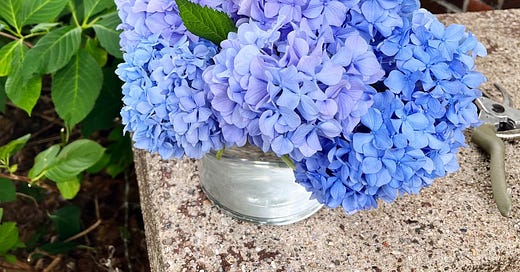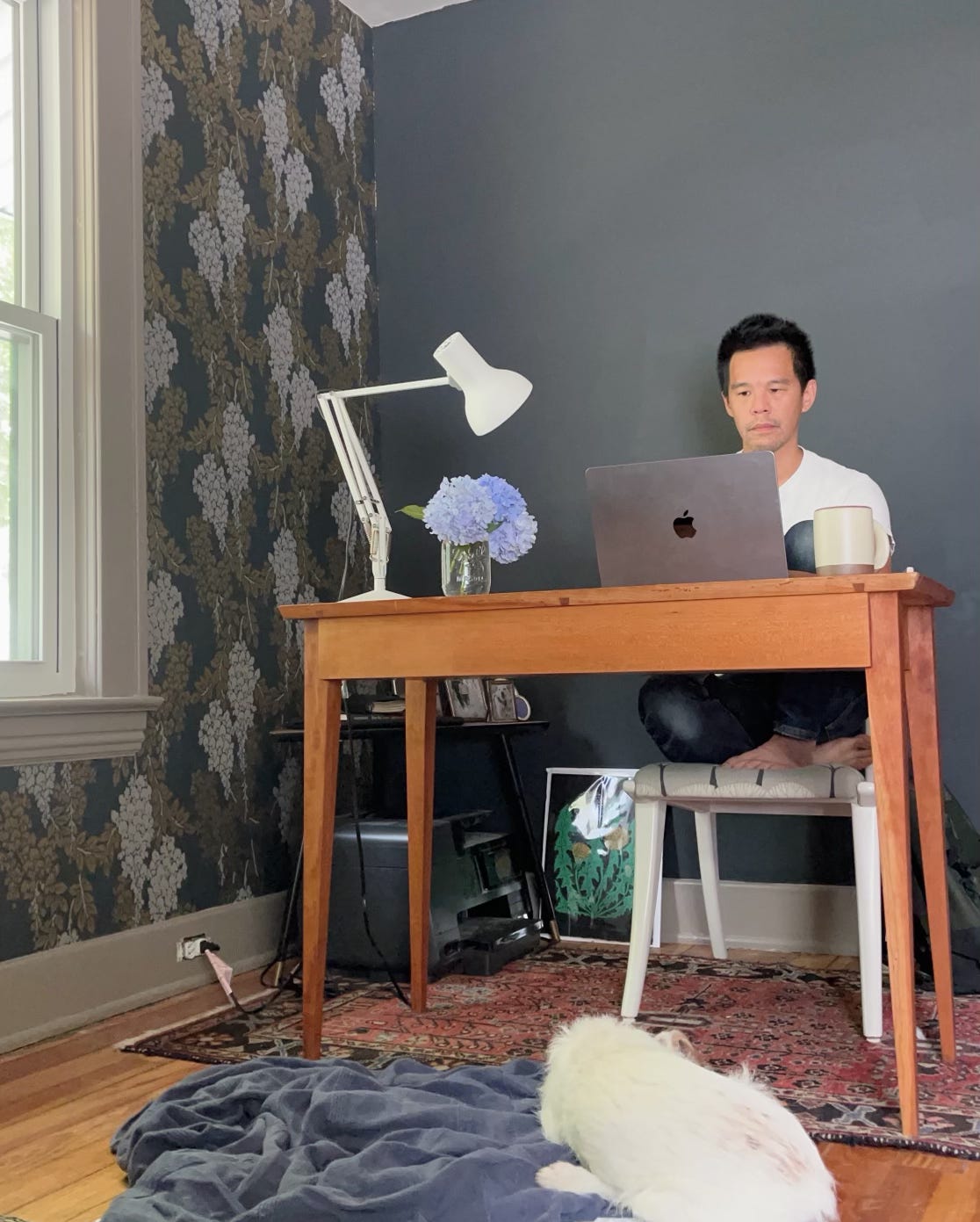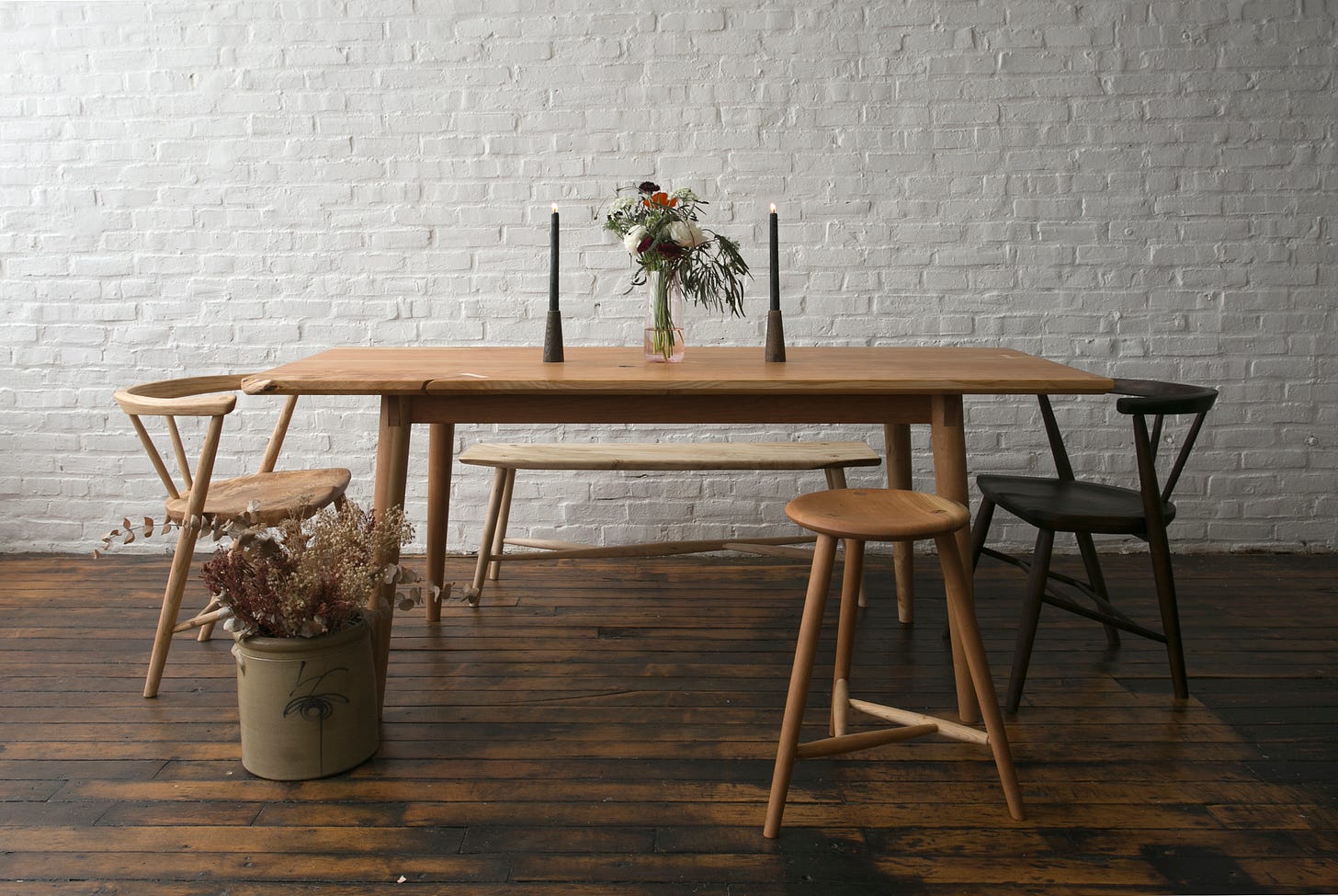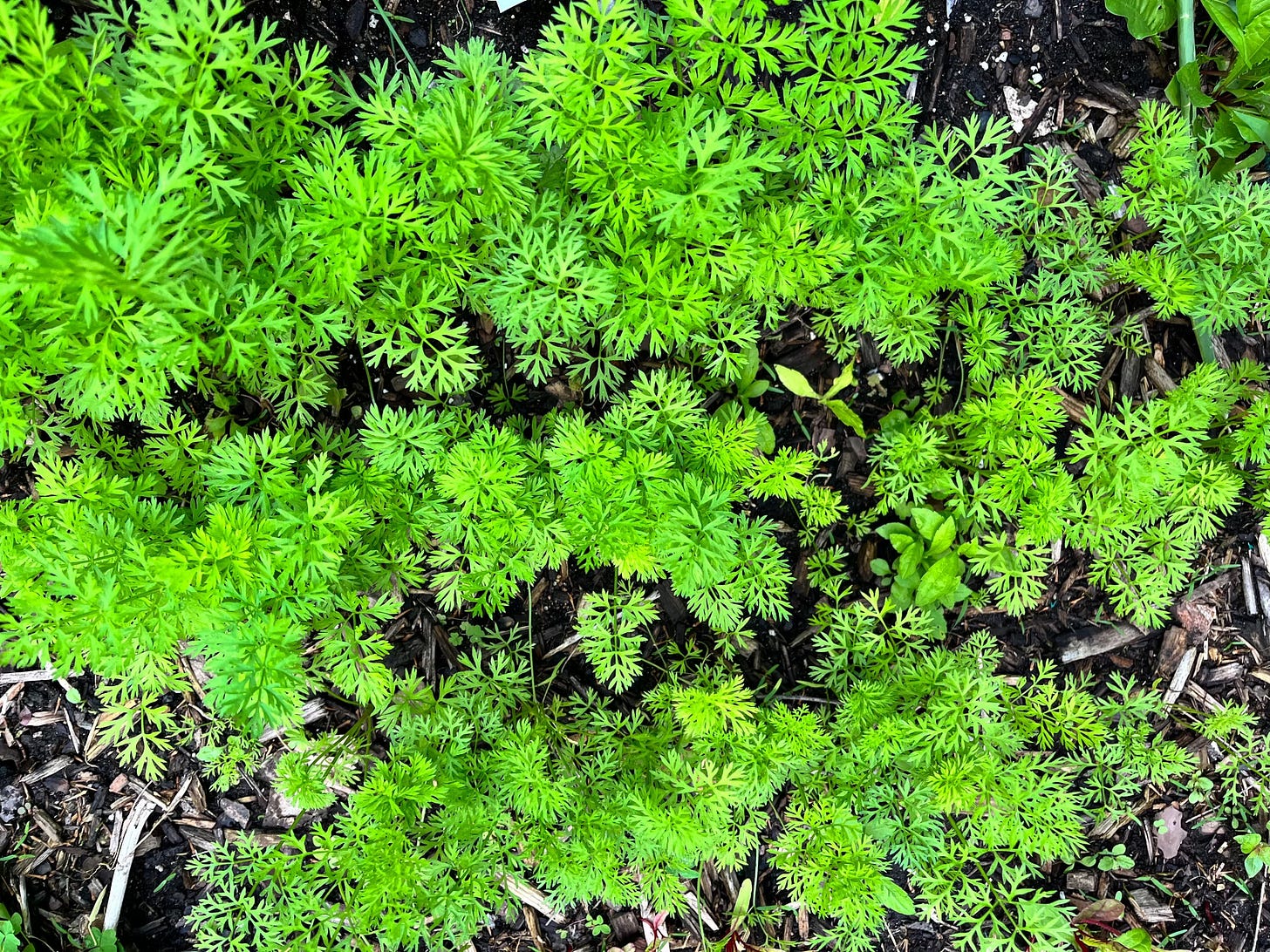Beauty and Goodness
Some fragmented thoughts on making things that last, a small furniture company in Philadelphia, blossoming hydrangea, thriving carrots, mangoes, and a surfing otter
Thursday, July 13
Grand Rapids, Mich.
Some time ago, I came across a fascinating compilation of photos of the spaces in which famous authors wrote. I almost typed “photos of famous authors’ desks,” but the picture of screenwriter Dalton Trumbo shows him in a bathtub. The one of J.D. Salinger—well, let’s just say he’s in the wild. I was surprised and indeed comforted to see how cluttered so many writers’ desks were—and still, words that mattered emerged from those messes.
When we moved to Grand Rapids in 2020, I got a dedicated study for the first time in my life. But a desk? I haven’t had a desk of my own since childhood. Of course I had desks in the offices I’ve occupied, but never in my own home. In Brooklyn, I wrote mostly at Cafe Martin, a coffee shop near our house. For the past three years, I’ve used a lovely old wooden card table that Tristan inherited from his grandparents; one neat feature is that the folding top doesn’t attach securely to the base, so if I lean too hard, things go flying.
Last year, after signing the book contract for Good Soil, I finally set aside some money to buy a desk. We could have driven a couple of hours to the nearest Ikea. I found a few things I liked online. But of course I overthink everything, so I wanted something with more personal meaning.
George Nelson, who created some of the most memorable pieces in the portfolio of Herman Miller, the furniture maker that is headquartered about 25 miles from my house, was not just a famed furniture designer but also a design theorist. “No design can exist in isolation,” he wrote. “It is always related, sometimes in very complex ways, to an entire constellation of influencing situations and attitudes.” In Nelson’s view, a “good” design “achieves integrity—that is, unity or wholeness—in balanced relation to its environment.” In other words, context matters.
Context, as Nelson notes, goes beyond the physical. Among my “influencing situations and attitudes”: My conviction that spaces matter. My belief that architecture and design express our values—even our theology. My desire to support a small business. My view that the stories our objects tell contributes to their beauty.
After months of dithering and Googling, I emailed an acquaintance, Greg Fuguet, who, with his spouse, Kristen Snow, operates a small, fine-furniture company in Philadelphia called Fuugs Woodworking.
I’ve long admired the things that Greg and Kristen make. Both are trained sculptors. Greg started making furniture for himself, out of necessity “as a poor recent graduate,” he told me recently. Then he began making pieces for family and friends, and eventually, it became a business. “As craftspeople, we want to make the best product we can from a design standpoint,” Greg said, “something that looks and functions the best.”
As Greg and Kristen considered not just what they were making but also how they were making it, they realized how multifaceted good design could be. “We wanted to make something that has the best story, the best future, the best impact on our piece of the world that we can touch,” Greg said. “How does it feel for your body to be using it? Does it add joy? Does it enrich your home? Does it look beautiful?”
Beauty isn’t merely aesthetic. It can manifest in all different ways. The word “beauty” has Anglo-Norman roots, and one of its root words means “goodness.” Kristen was exploring beauty and goodness in her own ways, reading and thinking theologically and mulling issues of environmental responsibility and sustainable living. “I was re-engaging with my fascination with and appreciation for the relationship we have with the earth—the interconnectedness of it all,” she said. Their list of questions lengthened: “Does it enrich the planet? Does it help perpetuate cycles of good?”
One piece of perpetuating cycles of good was disrupting cycles of bad. For the past decade, they have salvaged fallen or dead trees in and around Philadelphia. “Tons of wood just gets chipped or turned into firewood or brought straight to a landfill,” Greg said. “We decided to insert ourselves into the waste stream, try to divert some of what was getting wasted, and turn it into something that would be used for years—and maybe generations—to come.”
Early on, Greg had roamed Philadelphia, becoming the woodworking equivalent of a dumpster diver. “If the city had to take down a tree and didn’t move it immediately, I’d think, Free log!” he said.
This didn’t always work out well. One day, he spotted a fallen tree in Neshaminy State Park, which sits northwest of the city on the Delaware River. “It was destined for the firewood pile, and I was trying to save it,” Greg said. A park ranger spotted him. At first, the ranger accused Greg and Kristen of dumping the tree in the park. Then he changed his mind and decided that they had actually cut down a tree in the park. “I think we’re technically not allowed to go back to that park,” Kristen said.
As their reputations spread, people began calling with news of dead trees. They’d hook up the trailer, load up their portable saw mill, and get to work. The wood for my desk came from a cherry tree on the grounds of the Upsala House, a historic mansion in Philadelphia’s Germantown neighborhood. “They had me come mill an ash tree that had been killed by emerald ash borers. They said, ‘Oh, hey, we also have this tree that was destroyed by ivy.’ I peeled off maybe six inches of ivy root and vine. It was dead,” Greg recalled. “I got two 10-foot logs out of it.”
Greg and Kristen now have a long-term partnership with Philadelphia’s Awbury Arboretum. The 55-acre estate abounds in birch, oak, and maple, and they get to salvage whatever falls or needs to be cut down. That’s a more reliable supply chain than scavenging the streets. It’s also a key factor in making Fuugs Woodworking a carbon-negative operation—in other words, one that sequesters more carbon than it emits. “We’ve done the math,” Kristen explained. Every tree they save and mill is a tree that’s “not decomposing in landfills and releasing the carbon it has sequestered back into the atmosphere. As long as the furniture piece exists, it is containing the carbon that the tree sequestered.”
Which points to another goal: creating furniture that endures. While many consumers have become conscious of fast fashion, there has been less awareness about furniture. “By having furniture that’s made to last for generations, you’re not renting your furniture from the earth,” Kristen said. “You might have something for five years and then it starts to break, so you buy a new one and the old one goes into a landfill, and then you do it all over again. Over the course of a lifetime, that could happen five or ten times over—or you could have one piece of furniture that is well made and that lasts and that you could potentially pass on.”
Such furniture is, of course, not inexpensive. A Fuugs dining table costs upward of $5,000, a stool at least $500. (They also make smaller, more affordable items; their candle holders are $30, and I recently bought a walnut rolling pin for $50.) The cost reflects the painstaking labor of hand-crafting according to traditional techniques—my desk has beautiful dovetail joints and an exquisite maple bowtie in the top—as well as the expense of running a small business. “This is not a get-rich-quick scheme,” Kristen said with a wry smile. They’re just eking by. “We tell people all the time that we can’t even afford our own furniture,” Greg said. “It’s awkward.”
Still, the two are not giving up on their vision of a business that is as sustainable and inclusive as possible. While designing their Yarrow line of furniture last year, for instance, they considered how the chairs might feel to bodies of all different shapes and sizes, testing and refining prototypes with the help of friends who were tall and short, fat and thin. Last fall, they took the chairs to a craft show. “We had people of all different sizes try the chairs and say, ‘Most chairs aren’t that comfortable for me, and this one is,’” Greg recalled. “They felt like we did something specifically for them. They felt considered. That was really satisfying. We could make the most beautiful, historically inclined chair, but if it hurts to sit in it, we missed.”
If they can get the business onto firmer financial footing, “our plans and intentions are to put the money back into Philadelphia,” Kristen said. “Could we create a sliding scale for people here who can’t afford our product? It means a lot to have a piece of furniture from the place you live. How do we redistribute wealth?”
Regardless of whether someone ever buys something they make, though, they hope that all who encounter their work will pay more attention to their surroundings. “Think about what you’re using your space for and what the objects in your space represent. Where do they come from? What are the cycles? What is the history?” Kristen said. Greg concurred: “If we can just get people to look at the objects that they choose to live their life with and really think about where they came from and where they’re going, that would be great.”
You can read more about Greg and Kristen’s work at fuugs.com. You can also follow Fuugs Woodworking on Instagram.
What I’m Growing: Out in front of the house, the hydrangea are in full bloom. To me, they embody grace; we didn’t plant them, and I barely do a thing to keep them going, beyond an occasional, seasonal trim. We simply get to receive and be reminded once again of all the beauty that is out there just waiting to be noticed.
From the department of things that I am allegedly responsible for: The carrots seem to be doing better this year in the backyard than in previous seasons. This surprised me, given the dry spring we had; I’d been told that carrot seeds need to be kept consistently wet—I am not using the “m” word here because I really do not like it—but not too wet.
In Cantonese, carrot is called 紅蘿蔔, which can be translated “red radish.” Though my mother would use carrots in her beef stew as well as in her spring rolls, they aren’t ubiquitous in Cantonese cuisine. I think they’re more frequently used in other Chinese cuisines. In Mandarin, the carrot is traditionally 胡蘿蔔, which means “barbarian radish,” because it didn’t arrive in China until medieval times.
I don’t think the “barbarian” was meant as an insult so much as a record of its origins. As I’ve read up on Chinese cuisine, I’ve realized how many ingredients are marked to indicate their provenance: spinach is 菠菜, literally “Persian vegetable,” snow peas, which are so common in stir-fry, are 荷蘭豆—“Holland peas,” sweet potatoes are 番薯—“foreign yam,” and watermelon are 西瓜—“Western melon.” This is why I love being a word geek. Sometimes words can tell you so much, if only you think to ask.
What I’m Reading: Two stories for you this week, from two states where I grew up.
In Miami, where I went to high school, we had two large mango trees in our front yard and at least four or five in the back. When harvest season came, I’d help my mom gather the ones that had already fallen. Sometimes, I’d also take the fruit-picking pole, which looks like an elongated lacrosse stick, except with a tines and basket on the end where the mesh would be, and pull the ripe mangoes down. Some started out green and purple, eventually turning red, while others grew golden.
Guests who came to stay during those months would leave with bags of mangoes. If we were heading to California for a visit, we’d carefully pack them in our suitcases and then hand them out as gifts. If we weren’t traveling and we had extra—we always had extra—my mom would bag them up and take them to a nearby Asian grocery store, where she’d barter them for the Chinese vegetables we liked.
So it was a delight to read this New York Times story about the significance of mangoes in Miami. (This link should be accessible to everyone, regardless of whether you have a Times subscription.) “Mango culture,” one professor says in the story, “is now one of the very few things that joins people together in this incredibly fractured metropolitan area.”
When I first saw a tweet about a California sea otter who has taken up surfing, I thought it was cute. Only a few thousand California sea otters remain. This one, known as 841, seemed a remarkable ambassador for her endangered kind. Then I read that “if a human should be bitten, the state has no choice but to euthanize the otter,” and I learned more about this otter’s backstory: how she’s the daughter of an otter that had acclimated to human contact, how she was born in an aquarium, how she was then released into the wild. What started out as an adorable “animals—they’re just like us!” storyline gradually complexified into a sobering one about how, once again, humans have imposed themselves on nature and in doing so have created no small amount of difficulty for once-abundant creatures that are just trying to survive.
I got a message recently from someone who said they wished I would offer a take on some big controversy that had been in the news. Thing is, I can pretty much guarantee you that, on almost any issue in the headlines, someone else has more erudite, more informed commentary. Anyway, that seemed like a good opportunity to offer a little explanation about what I’m trying to do when I write to you each week.
My focus tends to be on the things that are small but not insignificant. I’m just trying to do a better job of paying attention to the world around me, and whatever I share is offered in the hopes of encouraging you to do the same. There is so much goodness, so much beauty, around us. There’s grief and pain and suffering too, of course. But our flourishing will only be possible if we draw strength from all that’s good and beautiful, and our survival will only be something beyond survival if we have the opportunity to wrestle with the grief together, offer balm for each other’s pain, meet suffering with empathy and hope, and point one another toward possibility.
Let me say it one other way: I’m not a very good gardener. Still, I keep trying to grow things, and each season, I try to get a little better at understanding the land, tending to my crops, learning how to care for other living things, and loving this aching world and all that inhabits it. I think we can all do this. Sharing stories helps me—and I hope it will help you.
I’m so glad we can stumble through all this together, and I’ll try to write again soon.
Much love,
Jeff











Jeff, I really love your writing. It's luminous and gentle and such a balm in this "aching world" as you so accurately call it. Thank you.
I am so thankful for your writing. My husband and I recently acquired a set of end tables his grandfather made in the late ‘60s. The same week we put them in our living room, my husband finished a walnut bar for our basement. It’s so lovely looking around our house at the things we’ve made or have been passed down from people we love.